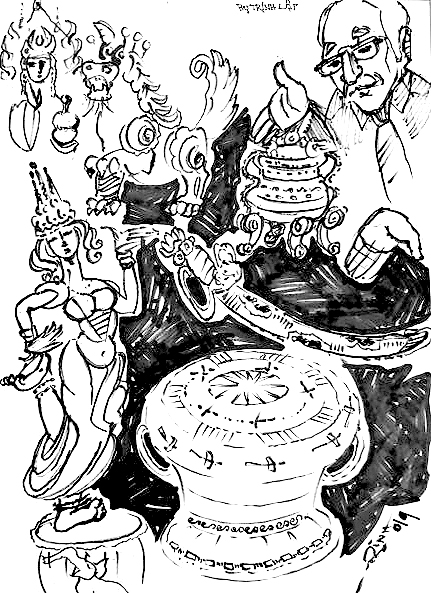
Illustration by Trịnh Lập
by Nguyễn Mỹ Hà
French President Emmanuel Macron recently pledged to return artworks seized by colonialists over 100 years ago to Benin, West Africa.
Twenty-six artworks, including a royal throne, will be returned over the next two years as a result of his promise.
This act is unprecedented between France and its former colonies.
And it rang a bell.
Vietnamese fought the French colonialists and won the world-shaking Battle of Điện Biên Phủ in 1954, but nothing has been mentioned regarding looted artworks and royal treasures which have not been returned.
Việt Nam had a painful 80-year-old history with France, when the country was occupied, conquered and manipulated, then later rose up to down the French colonialism.
From 1887, together with Cambodia and Laos, Việt Nam (then named Đại Nam), merged into French Indochina.
The North, Centre and South of Việt Nam became Tonkin, Annam and Cochinchina, respectively, all under one French flag. The royal crown, whose flag was yellow with a red sun, in theory still ruled Annam, but actual power was in the hands of the French.
During World War II in Europe, France was occupied by the Nazi Germany and the Vichy government came to power. In its Asian colonies, the Imperial Japanese army overthrew French colonial rule and later surrendered after the Allies defeated the Nazis in 1945.
The Việt Minh (League for the Independence of Việt Nam), led by Hồ Chí Minh, who had been encouraging the people to fight the French occupation for years, took the opportunity with the major powers out of the picture to declare Việt Nam an independent and democratic country.
For the first time in 80 years of being occupied, dominated and exploited, Việt Nam was one free country. But freedom and independence did not last long, and by December 1946, the French, with all its military power returned to the country to reclaim domination.
President Hồ Chí Minh and his government had to evacuate to the countryside, waging a nine-year long resistance war, which is often known in the West as the First Indochina War, until the final battle in the valley of Điện Biên Phủ.
In order to create a political alternative to the Việt Minh, the State of Việt Nam, led by former Emperor Bảo Đại, was proclaimed in 1949 in the French-controlled areas.
What happened in Điện Biên Phủ shook colonial powers to their core. Following the Geneva Accord in 1954, Việt Nam was divided into two parts, with the north following President Hồ Chí Minh, and the south led by French-backed Bảo Đại.
At last the French had to leave South Việt Nam when Armerian-aided and abetted Ngô Đình Diệm toppled Bảo Đại and set up the Sài Gòn administration in 1956.
A museum to showcase Asian art, the largest of its kind not located in Asia, was established in Lyon in 1879. Ten years later, the Guimet Museum was moved to Paris.
At the Guimet, you can find artworks from China, Pakistan, Afghanistan, India, Cambodia, Laos, and last but not least, Việt Nam.
The Guimet boasts a large bronze drum collection from the Đông Sơn era, also known as the Bronze Age (from 1,000BC to the first century AD) in the Red River Delta, the cradle of modern Việt Nam today.
On some social networks, historians and researchers have stated the desire for Việt Nam to reclaim its ancient treasures.
"They (the Guimet) have the best Đông Sơn collection," according to a noted archaeologist, who said she believed the job of retrieving the looted art lay in the hands of the Ministry of Culture.
A question directed to the front office of the Ministry of Culture did not get any official answer before this article went to print. An official speaking on condition of anonymity said this should wait until a general meeting when a decision would be made after careful consideration of expert reports.
From the average citizen's point of view, some say they would like to see the treasures brought back to Vietnamese museums, while some jokingly say just leave them for the French to protect them for us. VNS
OVietnam